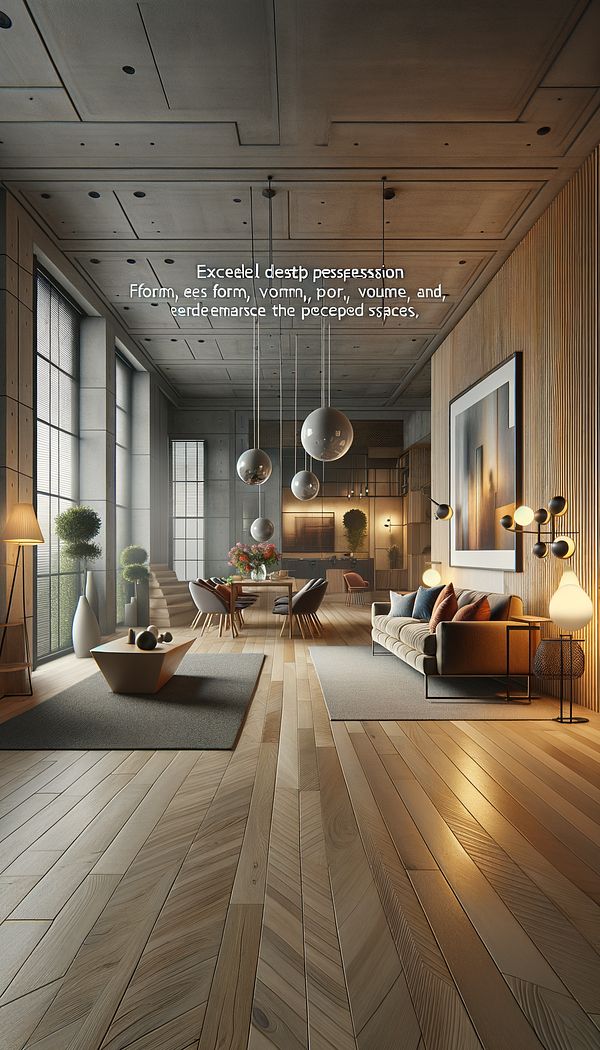What is Depth?
Depth is the perception of three-dimensional space in a design, contributing to its complexity and visual interest.
Description
In interior design, depth plays a crucial role in creating visually captivating spaces that invite exploration and evoke emotions. It involves the strategic arrangement of objects, textures, colors, and lighting to imply dimensions beyond the two-dimensional plane. Depth can transform a flat, uninteresting room into a dynamic environment with layers of meaning and nuance.
By using various techniques such as contrasting colors, varying textures, and carefully positioned lighting, designers can create the illusion of depth. These techniques can also help to guide the viewer's eye through the space, establish focal points, and balance the overall composition of a room. Incorporating elements at different distances from the viewer's perspective, such as furniture, wall art, and decorative objects, also contributes to the perceived depth.
Understanding and manipulating depth requires a keen eye for detail and the ability to visualize a space in three dimensions. This skill allows designers to maximize the potential of both large and small spaces, making them appear more spacious or cozy as desired. Properly executed, depth can elevate the aesthetic quality and functionality of interior spaces, making them more engaging and comfortable for occupants.
Usage
To enhance the sense of depth in a living room, a designer might use a deep, rich wall color behind a lighter-colored sofa, add textured throw pillows for contrast, and strategically place lighting to highlight the room’s features. Additionally, layering rugs of varying textures and patterns can add visual interest and further contribute to the depth of the space.
FAQs
-
How does lighting affect depth in interior design?
Lighting can significantly affect the perception of depth by creating shadows, highlighting textures, and drawing attention to specific areas. Strategic lighting placement can enhance the three-dimensionality of objects and spaces, making them appear more distinct and dynamic.
-
Can depth be created in small spaces?
Yes, depth can be effectively created in small spaces by using light colors to make the room appear larger, incorporating mirrors to reflect light and scenery, and choosing furniture and decor that offer a variety of textures and heights. These strategies can help to create the illusion of more space.
-
What role do textures play in creating depth?
Textures add visual weight and interest, helping to create depth by providing contrast and diversity in a space. Different textures can mimic the varied surfaces found in nature, adding complexity and inviting touch, which enhances the sense of depth.
Practical Application
When planning to add depth to a space, consider the room's layout and how objects interact at different levels and angles. Think about how light both natural and artificial influences the mood and visual perception. Experiment with different materials, colors, and textures in furniture, flooring, and wall treatments to see how they contribute to the overall depth. Remember, the goal is to create a cohesive, engaging space that entices people to explore and feel comfortable within it.
-
Lighting111 articles
-
Space Planning & Layout134 articles
-
Decorating Principles & Elements330 articles
-
Materials & Textiles360 articles
-
Color & Patterns154 articles
-
Zen DesignZen Design is an approach to interior design that emphasizes simplicity, natural beauty, and harmony.
-
Rolled ArmsRolled arms are a style of sofa and chair armrests characterized by their rounded, curling shape.
-
LimewashLimewash is a type of paint made from limestone.
-
SlipcoverA slipcover is a fitted protective cover that can be slipped off and on a piece of furniture.
-
Bandy LegBandy Leg refers to a curvature present in furniture legs.
